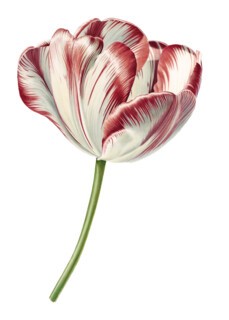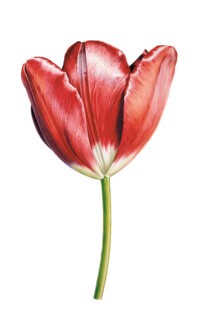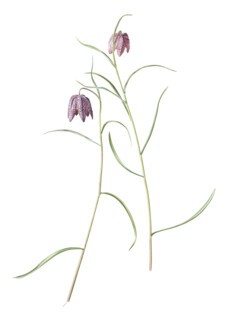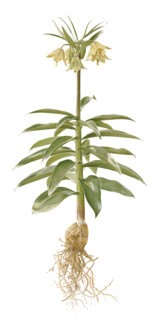In the early 1970s, the Scottish artist Rory McEwen painted several pieces he called True Facts from Nature. Like most of his work they are botanical subjects, sharply painted in watercolour on vellum, a technique that achieves a shimmering luminosity. True Facts from Nature No.12 (c.1973) sets out six specimens equidistant in a row. Each is a fragment, but each has the quality of self-possession characteristic of McEwen. From left to right they are a broken bud, a small leaf lightly withered, a larger leaf also withered, a piece of bark, three seed pods, a torn branch and a sycamore seed with one wing missing. Writing about another series of leaf paintings, which he titled by the places where they were found rather than by species, McEwen said that ‘every one of them is like a personality.’ This True Facts parade of dishevelled specimens has an air of something like defiance, as if in a police round-up of usual suspects, and reflects McEwen’s description of his artistic purpose: ‘to make demonstrations on behalf of the natural order’.
He also painted subjects more usually associated with botanical artists since the 17th century. Tulips, fritillaries and auriculas throng the Driehaus Museum in this last leg of A New Perspective on Nature’s American tour (until 17 August). McEwen was respectful of the tradition of flower painting epitomised by Pierre-Joseph Redouté, on whom he wrote an undergraduate thesis, but the exhibition’s suggestion that McEwen was ‘the Redouté of our time’ is somewhat misleading. His work is not only less concerned with conventional ideas of beauty, it lacks any obvious desire to please. It was in itself a perverse choice for an artist in the 1960s to take up flower painting, so far out of fashion as to be invisible from the modernist avant-garde. Yet, after McEwen’s death, Douglas Hall, the pioneering first keeper of the Scottish National Gallery of Modern Art, reflected that ‘paradoxically’ his choice of subject had made McEwen ‘most truly an artist of his time. For while a good many artists could work in these idioms of modernism, none could paint an auricula or an onion as he could while possessing the consciousness of a modern artist.’
That consciousness is apparent in the sometimes startling scale of the images, an onion one-and-a-half times life size, a tiny rosebud, its fragility compounded by its position off centre in a wide, white space. There are none of the trompe l’oeil shadows often used by traditional flower painters, and images shift in their relation to the frame, often asymmetrically placed, unusually angled or seeming to extend beyond the picture. Tulip (Red and Yellow) from 1976 is seen from below, bending away from the viewer as if it would like to leave, while the sycamore leaf in Dutchman’s Farm, Eton (1979) is caught doing just that, its top half out of sight, its bottom half and stalk suspended like Jesus in a medieval Ascension.
McEwen was well aware of the avant-garde of the 1960s and 1970s, and not antagonistic to it. Cy Twombly and Jim and Nancy Dine were his friends. Dine wrote that ‘he was touched by God, not just with the skills of an artist, but with all skills,’ a bit of hyperbole that nevertheless reflects a truth about the impression McEwen made in his life. He was born into a Scottish gentry family, the son of Sir John McEwen, Conservative under-secretary of state for Scotland, and his wife, Brigid Lindley. Rory and his five brothers and one sister grew up in Berwickshire in the family’s Palladian mansion, Marchmont. Commenting later on his interest in Redouté, he wrote that ‘I was born in an 18th-century house, brought up, truth to tell, in the 18th century.’ He went to Eton and read English at Cambridge, where he met Nick Tomalin, Hugh Thomas, Mark Boxer and Neal Ascherson.
Among the enduring friendships of his student years was that of the founding editor of the LRB, Karl Miller. McEwen and his wife, Romana, later went on a road trip with Karl and his wife, Jane, through the Blue Ridge Mountains in the Millers’ elderly Buick. As a handsome, talented, well-connected Old Etonian, McEwen attracted unimaginative comparisons with Sebastian Flyte. Miller recalled that he was ‘a bit of a liability from a left-wing point of view’, but added that it was ‘hard to imagine he was resented’. Though he took his own path in life, McEwen was not a rebel. He never disguised or repudiated his background. Ascherson, who found him ‘irresistible’, described him as ‘just confident in what he did’. The poise, combined with an element of the unexpected, is there in the work. McEwen’s confidence was real but not absolute. Considering his future in 1965 he asked himself in a note: ‘What is the best I can do with what I am?’
What he did immediately after Cambridge was become, along with his brother Alexander, an internationally famous folk singer. Having grown up listening to their older brother’s blues records, the McEwens made a pilgrimage to the US, visiting Lead Belly’s widow to see his 12-string guitar and finding themselves, with a characteristic combination of charm, talent and luck, appearing on The Ed Sullivan Show twice. In Britain, McEwen’s TV show, Hullabaloo, in which he compered and performed, was hugely popular. Van Morrison remembers him as an early influence. But the folk music scene of the early 1960s was fraught with political and artistic division and here, if not at Cambridge, McEwen was resented, as George Melly put it, ‘for his upper classness and his education’ and perhaps his very lack of political interest. Around the time Dylan was being booed off stage at the Newport Folk Festival, McEwen decided to quit. He stopped playing professionally and went back to visual art for good. His first show in New York at the Durlacher Gallery was a critical success. Rachel Lambert ‘Bunny’ Mellon was impressed. She bought three pictures and gave two of them to her friend Jacqueline Kennedy to hang in the White House. McEwen later met Jackie and explained that the tulips were from the collection of the Wakefield and North of England Tulip Society, of which he was a patron. She was, he noted, ‘very interested’.
An unlikely conversation in an age of improbable meetings. McEwen, hospitable, open-minded and curious about people, was perfect for the 1960s. In Chelsea, he and Romana kept an open house where George Harrison first met Ravi Shankar and the actor Peter Eyre remembered seeing Barbra Streisand talking to Jonathan Miller, who liked to ‘arse around’ doing sketches while McEwen played. The party carried on later in Scotland, where on his brother’s death McEwen bought Bardrochat, the other family house, an Arts and Crafts mansion in Ayrshire with a music room by Robert Lorimer. The genial chaos of country house life disconcerted some visitors. The photographer Lee Friedlander thought it was like ‘being in the middle of a British novel’, speculating that there were probably people who stayed the whole summer. McEwen was ‘the catalyst’ and centre of events. But even amid the ‘frenzied activity’ of some forty guests, and the associated ‘walking, sea bathing, football, ping-pong’, he continued to work (‘a kind of mole-like activity in my studio’). He used surgeon’s spectacles for fine details, describing his method as: ‘Looking, looking and thinking; then painting, and then thinking how much better the painting could be’.
Glen Baxter, who became a friend in the mid-1970s, thought that while ‘moving in all these peculiar circles’, it was his art that gave McEwen ‘sanity and peace and harmony’. McEwen’s own account suggests the opposite, that social life offered a refuge from his subject matter. ‘The countryside around about is bewilderingly beautiful,’ he wrote from Scotland in 1975, ‘and is beginning to drive me slightly crazy. I wonder if this is what Mondrian felt, finally refusing even to look out of a railway carriage window … I feel threatened by the variety of green, blue, umber.’
His career, though thriving, was confined by the marginal status of botanical art. The kind of recognition his friends and contemporaries achieved, the big international shows, eluded him. ‘I feel there is another stream I should be bathing in,’ he wrote to a friend, a ‘distant possibility’ of something ‘fine fresh dangerous … please God let me get to a big oil painting before long.’ He made forays into sculpture and abstraction but the drive towards the ‘reality’ of physical appearance was relentless, ‘like something I’m forced to do’. The examples of his non-botanical work in the exhibition have a tentative, unresolved quality, unlike the rest. It is in the later paintings, especially the series of single vegetables, that what Hall meant by modern ‘consciousness’ shines out most clearly. They hover on the edge of Pop Art while remaining realist; a chilli pepper past its best, curling top and toe, its red skin shiny like latex, and the pink and cream tulip ‘Helen Josephine’, lickable as a lolly. Wildflowers, by contrast, are handled with less familiarity. Fritillaries were among McEwen’s favourites. He felt a kind of awe for ‘these intense, wonderful little worlds of character’ that had almost to be dissected to discover their ‘tiny, jewel-like, secret, nectaries’. He admired the modesty of a subject whose ‘beauty is not flaunted’. The show includes part of a series he made in 1977 for a book which it seems never materialised. Having travelled to the places where fritillaries grow wild, in Greece, Afghanistan and Turkey, it was in Hampshire that he made his Fritillaria meleagris, a powerful portrait of a single delicate bloom, a heavy head and bone-thin leaves curving out beyond the frame. Fritillaria raddeana, hanging next to it, looks brazen by contrast, leaping in mid-air with its roots on show, pointed leaves propelling it upwards.
The exhibition has been deftly selected and arranged by Ruth Stiff, curator of international exhibitions at the Royal Botanic Gardens, Kew, at the head of a large group of lenders, advisers and funders. It brings together loans from private collections on both sides of the Atlantic including many from Bunny Mellon’s own collection, now part of the Oak Spring Garden Foundation. The show’s earlier tour venues were conventional galleries, but it seems fitting that McEwen, who lived in grand houses and loved domestic life, should have come to rest among the somewhat overbearing surroundings of the Richard Driehaus Museum. A Gilded Age mansion, completed in 1883 for Samuel Nickerson, president of the First National Bank of Chicago, it is furnished with Moorish tiles, Tiffany glass, marble, marquetry and mosaic, amid which McEwen’s work sits calmly and seemingly at home. Near the end of the exhibition any lingering impression of the gentlemanly dilettante is dispelled by an illustrated diary kept in the last whole year of his life. It records precisely the hours he worked and what he did, day by day. Having been diagnosed with cancer he gave the stock of vellum he would never now use to Carnegie Mellon University but continued his high-powered social life from hospital, calling Jackie Kennedy and Isaiah Berlin on the basis that ‘if you’ve got terminal cancer, you can ring anybody up.’ Later, however, an inoperable brain tumour gave him intolerable headaches and double vision, and he decided to ‘get out’. In October 1982, he took his own life. It was perhaps the shock at the sudden loss of such a vivid personality that all but froze his reputation until the turn of the century. This exhibition continues its revival but is not without poignancy. As Miller wrote, ‘at his quintessential best, the art of his later years was to deliver, life size, a single autumn leaf … the fallen leaf of requiem or elegy.’
Send Letters To:
The Editor
London Review of Books,
28 Little Russell Street
London, WC1A 2HN
letters@lrb.co.uk
Please include name, address, and a telephone number.





